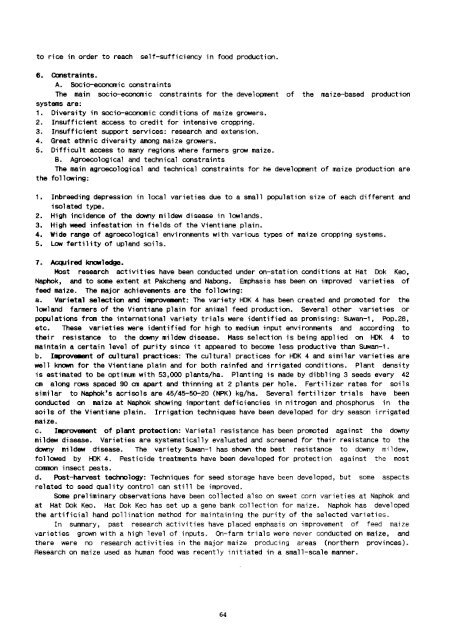Proceedings of the Fifth Asian Regional Maize Workshop - Search ...
Proceedings of the Fifth Asian Regional Maize Workshop - Search ...
Proceedings of the Fifth Asian Regional Maize Workshop - Search ...
You also want an ePaper? Increase the reach of your titles
YUMPU automatically turns print PDFs into web optimized ePapers that Google loves.
to rice in order to reach<br />
self-sufficiency in food production.<br />
6. Constraints.<br />
A. SOCio-economic constraints<br />
The main socio-economic constraints for <strong>the</strong> development <strong>of</strong> <strong>the</strong> maize-based production<br />
systems are:<br />
1. Diversity in socio-economic conditions <strong>of</strong> maize growers.<br />
2. Insufficient access to credit for intensive cropping.<br />
3. Insufficient support services: research and extension.<br />
4. Great ethnic diversity among maize growers.<br />
5. Difficult access to many regions where farmers grow maize.<br />
B. Agroecological and technical constraints<br />
The main agroecological and technical constraints for he development <strong>of</strong> maize production are<br />
<strong>the</strong> following:<br />
1. Inbreeding depression in local varieties due to a small population size <strong>of</strong> each different and<br />
isolated type.<br />
2. High incidence <strong>of</strong> <strong>the</strong> downy mildew disease in lowlands.<br />
3. High weed infestation in fields <strong>of</strong> <strong>the</strong> Vientiane plain.<br />
4. Wide range <strong>of</strong> agroecological environments with various types <strong>of</strong> maize cropping systems.<br />
5. Low fertility <strong>of</strong> upland soils.<br />
7. Acqui red knowl edge.<br />
Most research activities have been conducted under on-station conditions at Hat Dok Keo,<br />
Naphok, and to some extent at Pakcheng and Nabong. Emphasis has been on improved varieties <strong>of</strong><br />
feed maize. The major achievements are <strong>the</strong> following:<br />
a. Varietal selection and improvement: The variety HDK 4 has been created and promoted for <strong>the</strong><br />
lowland farmers <strong>of</strong> <strong>the</strong> Vientiane plain for animal feed production. several o<strong>the</strong>r varieties or<br />
populations from <strong>the</strong> international variety trials were identified as promising: Suwan-1, Pop.28,<br />
etc. "rhese varieties were identified for high to medium input environments and according to<br />
<strong>the</strong>ir resistance to <strong>the</strong> downy mildew disease. Mass selection is being applied on HDK 4 to<br />
maintain a certain level <strong>of</strong> purity since it appeared to become less productive than Suwan-1.<br />
b. Improve.ent <strong>of</strong> cultural practices: The cultural practices for HDK 4 and similar varieties are<br />
well known for <strong>the</strong> Vientiane plain and for both rainfed and irrigated conditions. Plant density<br />
is estimated to be optimum with 53,000 plants/ha. Planting is made by dibbling 3 seeds every 42<br />
em along rows spaced 90 em apart and thinning at 2 plants per hole. Fertilizer rates for soils<br />
similar to Naphok's acrisols are 45/45-50-20 (NPK) kg/ha. several fertilizer trials have been<br />
conducted on maize at Naphok showing important deficiencies in nitrogen and phosphorus in <strong>the</strong><br />
soils <strong>of</strong> <strong>the</strong> Vientiane plain. Irrigation techniques have been developed for dry season irrigated<br />
maize.<br />
c. Improvement <strong>of</strong> plant protection: Varietal resistance has been promoted against <strong>the</strong> downy<br />
mildew disease. Varieties are systematically evaluated and screened for <strong>the</strong>ir resistance to <strong>the</strong><br />
downy mildew disease. The variety Suwan-1 has shown <strong>the</strong> best resistance to downy mildew,<br />
followed by HDK 4. Pesticide treatments have been developed for protection against <strong>the</strong> most<br />
common insect pests.<br />
d. Post-harvest technology: Techniques for seed storage have been developed, but some aspects<br />
related to seed quality control can still be improved.<br />
Some preliminary observations have been collected also on sweet corn varieties at Naphok and<br />
at Hat Dok Keo. Hat Dok Keo has set up a gene bank collection for maize. Naphok has developed<br />
<strong>the</strong> artificial hand pollination method for maintaining <strong>the</strong> purity <strong>of</strong> <strong>the</strong> selected varieties.<br />
In summary, past research activities have placed emphasis on improvement <strong>of</strong> feed maize<br />
varieties grown with a high level <strong>of</strong> inputs. On-farm trials were never conducted on maize, and<br />
<strong>the</strong>re were no research activities in <strong>the</strong> major maize producing areas (nor<strong>the</strong>rn provinces).<br />
Research on maize used as human food was recently initiated in a small-scale manner.<br />
64

















